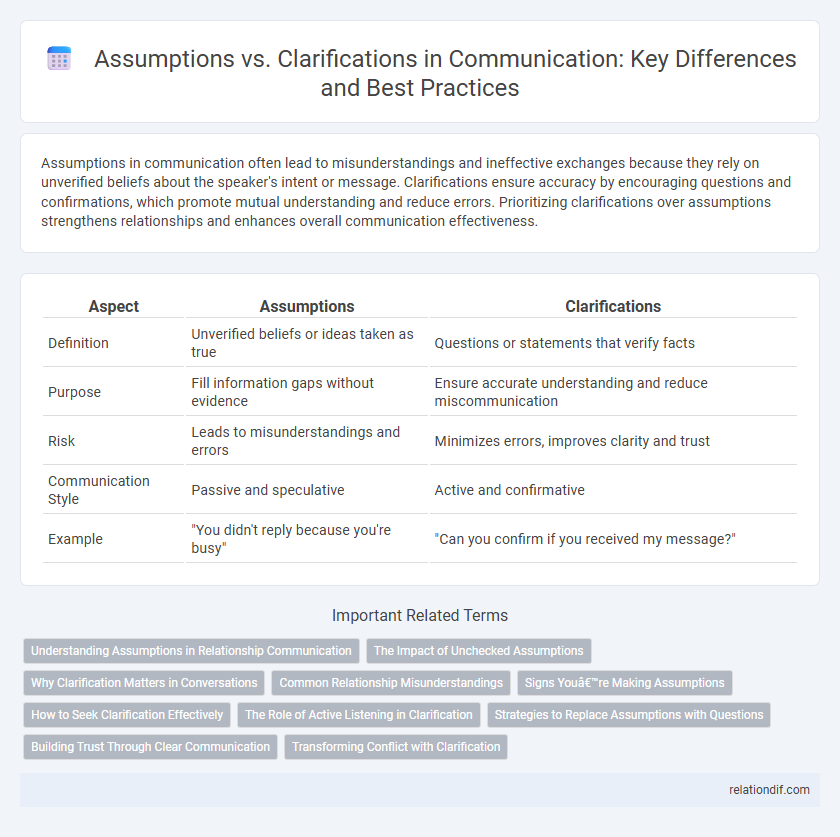Assumptions in communication often lead to misunderstandings and ineffective exchanges because they rely on unverified beliefs about the speaker's intent or message. Clarifications ensure accuracy by encouraging questions and confirmations, which promote mutual understanding and reduce errors. Prioritizing clarifications over assumptions strengthens relationships and enhances overall communication effectiveness.
Table of Comparison
| Aspect | Assumptions | Clarifications |
|---|---|---|
| Definition | Unverified beliefs or ideas taken as true | Questions or statements that verify facts |
| Purpose | Fill information gaps without evidence | Ensure accurate understanding and reduce miscommunication |
| Risk | Leads to misunderstandings and errors | Minimizes errors, improves clarity and trust |
| Communication Style | Passive and speculative | Active and confirmative |
| Example | "You didn't reply because you're busy" | "Can you confirm if you received my message?" |
Understanding Assumptions in Relationship Communication
Understanding assumptions in relationship communication involves recognizing unspoken beliefs or expectations that can lead to misunderstandings. Clarifications help by encouraging open dialogue, ensuring both parties interpret messages accurately and reducing the risk of conflict. Effective communication requires identifying assumptions early to build trust and promote mutual understanding.
The Impact of Unchecked Assumptions
Unchecked assumptions in communication lead to misunderstandings, decreased collaboration, and impaired decision-making, as individuals often interpret messages based on personal biases rather than facts. Failure to seek clarifications results in the propagation of misinformation and erodes trust between parties. Ensuring explicit verification of information enhances clarity, reduces conflicts, and fosters a more effective and transparent communication process.
Why Clarification Matters in Conversations
Clarification matters in conversations because it prevents misunderstandings and ensures that all parties share a common understanding of the topic. Assumptions often lead to misinterpretations, which can cause conflicts or errors in communication. Clear and precise clarification enhances trust, promotes effective decision-making, and supports successful collaboration in both personal and professional contexts.
Common Relationship Misunderstandings
Assumptions in communication often lead to common relationship misunderstandings, such as misinterpreting tone, intentions, or unspoken expectations. Clarifications help to bridge these gaps by promoting active listening, asking open-ended questions, and confirming mutual understanding. Effective communication relies on minimizing assumptions and encouraging transparent dialogue to build trust and prevent conflicts.
Signs You’re Making Assumptions
Assumptions often arise when interpreting vague or incomplete information, leading to misunderstandings in communication. Signs you're making assumptions include jumping to conclusions without verifying facts, misreading tone or intent, and filling gaps with personal biases. Recognizing these behaviors helps improve clarity by encouraging direct questions and active listening.
How to Seek Clarification Effectively
To seek clarification effectively, ask open-ended questions that encourage detailed responses and verify your understanding by summarizing key points. Use active listening techniques, such as maintaining eye contact and nodding, to show engagement and foster an open dialogue. Avoid making assumptions by addressing ambiguities promptly and seeking specific examples or explanations.
The Role of Active Listening in Clarification
Active listening plays a crucial role in clarifying assumptions by ensuring the listener fully understands the speaker's intent and message. Techniques such as paraphrasing, asking open-ended questions, and providing feedback help identify and address misunderstandings early in communication. This process reduces errors, fosters mutual respect, and enhances overall effectiveness in interpersonal and professional interactions.
Strategies to Replace Assumptions with Questions
Effective communication relies on replacing assumptions with targeted questions to ensure clarity and understanding. Strategies include actively asking open-ended questions to gather accurate information and confirm interpretations before responding. This approach minimizes misunderstandings and fosters a culture of transparency and trust in conversations.
Building Trust Through Clear Communication
Assumptions can create misunderstandings that weaken trust, while clarifications foster transparency and demonstrate a commitment to accuracy. Clear communication reduces uncertainty and promotes mutual respect by ensuring all parties are aligned in their understanding. Incorporating regular feedback and asking questions solidifies trust and helps prevent conflicts in personal and professional relationships.
Transforming Conflict with Clarification
Transforming conflict through clarification involves replacing assumptions with explicit communication, which reduces misunderstandings and fosters mutual understanding. Clarifying intentions and perspectives helps to address underlying issues before they escalate into larger disputes. This approach enhances collaboration and strengthens relationships by promoting transparency and trust.
Assumptions vs Clarifications Infographic

 relationdif.com
relationdif.com